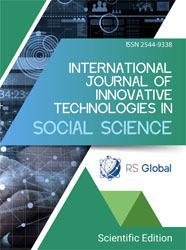LANDSLIDES IN THE CITY OF MILA BETWEEN THE SENSITIVITY OF THE LOCATION AND URBAN EXPANSION
Abstract
Cities are evolving rapidly, exposing them to natural hazards that can cause major human and environmental losses. The Algerian town of Mila is particularly vulnerable due to its complex geological and morphological environment, which favours various risks, such as landslides. The aim of this article is to highlight the risk of landslides in Mila, particularly in the Khirbet region. To analyse these risks, it is essential to define concepts such as natural risks, high risks, Algerian risks, the phenomenon, vulnerability and prevention. High risks are physical phenomena caused by fast- or slow-moving phenomena, while high risks are potential threats caused by exceptional natural or human activities. Vulnerability refers to the ability to withstand losses resulting from exposed areas and the fragility of the situation. Understanding and dealing with natural hazards in urban environments is crucial for sustainable development, preserving the urban environment and protecting citizens. The study revealed that natural factors, such as topography, geology, seismic activity and hydrology, play an important role The report recommends greater coordination between institutions and citizens, better knowledge of landslide risks, early warning systems and increased funding for disaster risk reduction and mitigation. Comprehensive and integrated approaches are needed to tackle climate and disaster challenges in Algeria. ground movements in Mila The report recommends greater coordination between institutions and citizens, better knowledge of landslide risks, early warning systems and increased funding for disaster risk reduction and mitigation. Comprehensive and integrated approaches needed to tackle climate and disaster challenges in Algeria.
References
Amireche, H. (2001). Water, substrate, tectonics and anthropization in the erosive sediments ofthe Tell Nord Constantinois (Algeria) (doctoral thesis). Mentouri University, Constantine.
Ahmed Daas. (2019-2020). Water governance is a key element for achieving sustainable development in Algeria: case study of the Beni Haroun dam in Mila (PhD, third year). SalehBoubenider University, Constantine 03.
Atmania, D. (2010). Mineralogy of clays and phenomena in the Mila basin (PhD thesis). Department of Earth Sciences, University of Constantine.
Chettah, W. (2008-2009). Investigation of the mineralogical and geomechanical properties ofmoving land in the city of Mila (North-East of Algeria) (Master’s thesis). Department of EarthSciences, Hadj Lakhdar Batna University.
Ogé, F. (2016). Module Introduction to Concepts and Principles of Environmental Law (EPR)Course materials, Open Archives, Paris, France.
Mebarki, A. (1982). The Kébir-Rhumel Basin - Surface Hydrology and Water Resource Management (PhD thesis, graduate degree). Nancy II University.
Durand Delga, M. (1969). Focus on the structure of the North-East Berbéria. Bulletin du Service Géologique et Carte d39;Algérie , 39, 89–113.
Antoine, P., Giraud, A., (1993): Help with the recognition of the main types of ground movements known in the Northern Alps. Commission of the European Communities, EPOCH Program, Part n°3, Vol n°2.
Aris, Y., (1994) : Etude tectonique et microtectonique des séries Jurassiques à Plio-quaternaires du Constantinois central (Algérie Nord-Oriental) : caractérisation des différentes
Antoine, P., Giraud, A., (1993): Help with the recognition of the main types of ground movements known in the Northern Alps. Commission of the European Communities, EPOCH Program, Part n°3, Vol n°2.
Azimi, C., Desvarreux, P., (1996): Some aspects of forecasting ground movements. Revue Française de Géotechnique, n° 76, pp. 63-71
Bonnard, Ch., (1984): Risks of instability. Multidisciplinary approach in the detection of landslides. Conference on land movements, Caen, France., n°1, pp. 309-316Muhammad Sabry Mahsoub, Muhammad Arbab: Risks and Natural Disasters, Dar Al-Fikr Al-Arabi, Egypt, 2000 AD.
Conseil National Economique et Social, Rapport sur "L’urbanisation et les risques naturels et industriels en Algérie : Inquiétudes actuelles et futures 322ème Session Plénière, Édition CNES, Alger, Mai 2003
National Economic and Social Council. (2003). Urbanization and risks: natural and industrial inAlgeria - Current and future concerns (Report). 322nd Plenary Session, CNES Edition, Algiers.
National Bureau of Statistics. (2008). General Census of Population and Habitat. National Bureauof Statistics, Constantine
Geotechnical study. (2001). Mila Land Use Plan. El Kherba - Mila site, Geotechnical and stabilitycontrol report.
CTC Mila. (2001). National Construction Engineering Inspection Organization (East).
Planning and Construction Directorate of Mila. (2001). Guidelines for Geotechnical Analysis and PDAU report of the Mila commune, APC of Milla, (2006) on 25-12-2018.
Report (PATW) Territorial development plan of the wilaya. From the town of Milla. Phase 1 (2012).
Report from POS No. 01 of the Mila commune, Technical study office in town planning. stability study report in Mila, LNHC-CTC-Constantine, June 2006. Office of Promotion and Real Estate Management-Mila (04/16/2019).
Google Arth + MN
Views:
48
Downloads:
33
Copyright (c) 2024 Bouguerroudja Nassima, Amirech Hamza

This work is licensed under a Creative Commons Attribution 4.0 International License.
All articles are published in open-access and licensed under a Creative Commons Attribution 4.0 International License (CC BY 4.0). Hence, authors retain copyright to the content of the articles.
CC BY 4.0 License allows content to be copied, adapted, displayed, distributed, re-published or otherwise re-used for any purpose including for adaptation and commercial use provided the content is attributed.















